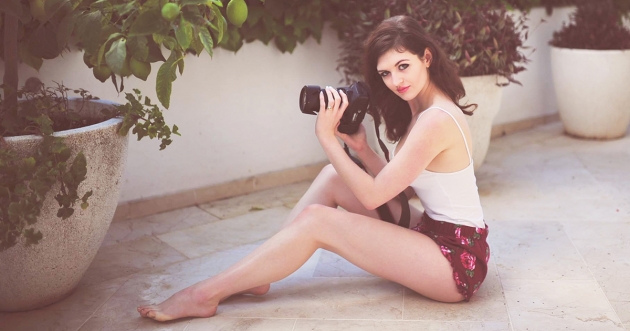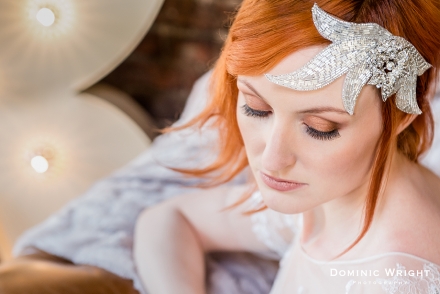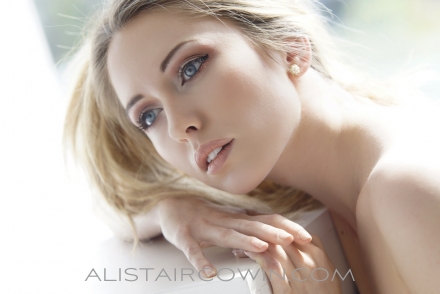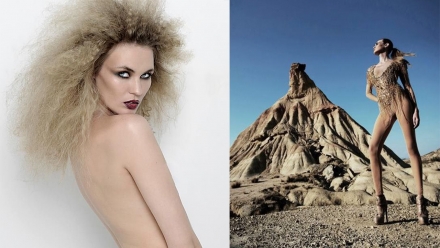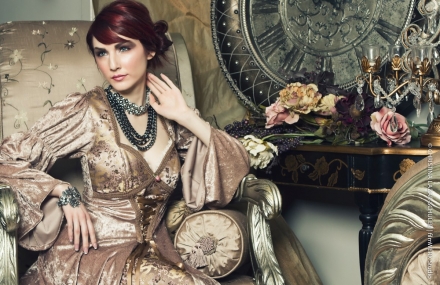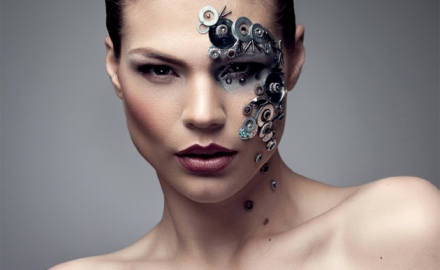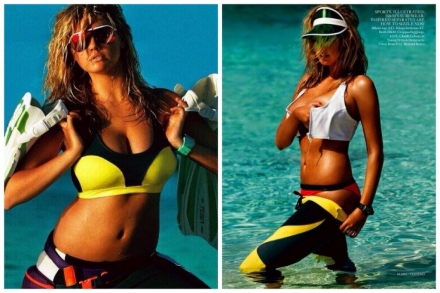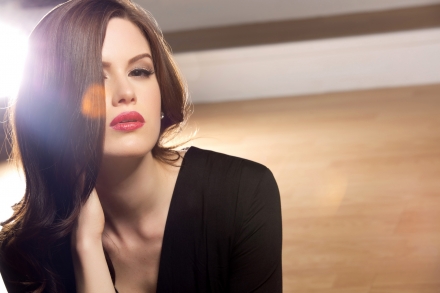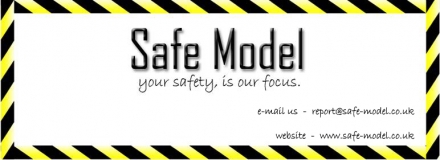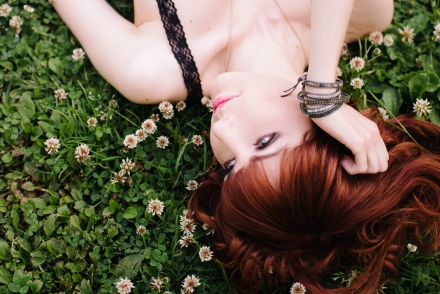Lizzie Bayliss is a model and photographer based in the UK. She has a background in fashion design, make-up artistry, and now also teaches photography masterclasses. Her book, ‘The Wise Girl’s Guide to Freelance Modelling’, will be released in June 2014.
What did you study at school/university, and what were the most useful subjects in retrospect?
I did the usual batch of GCSEs at 16 and got pretty good results, but I decided at that age to study fashion – the idea of modelling and photography hadn’t really occurred to me then. So I went to college aged 16, to do a two year national qualification in Fashion Design. I enjoyed it very much, and graduated with a triple distinction, but soon after I started the course, I was already modelling, and so my ambitions began to change direction. I was awarded a place on the most prestigious photography degree course in the UK, and should have started that at 18, but my partner and I were unable to sell our house so, after deferring the course start date two years running, I finally decided that I’d already learned more about photography than I might have learned on the degree course, so came to the conclusion that it would be a waste of time and money to do it.

Photo by Chris Zietek
How has your career improved since studying fashion design and make-up artistry?
There’s no doubt that my background in fashion design has helped my modelling and photography, not least in the styling that goes into sets. I did a national qualification in Make-Up Artistry as a distance learning project after finishing my Fashion Design Course, so now I am able to make up models who come to me for shoots.
Did you have a backup plan? What career would you have now if you weren’t a model?
I’m also a photographer and my work is getting favourable responses, so much so that I now run tutorials and masterclasses for other photographers; they are always over-subscribed. Along with my fashion and make-up qualifications, and the book I’ve written on modelling, I have quite a few spare strings to my bow, should one snap!

Photo by Outofrespect
What got you started as a model?
I was chatting to a guy on line who said he was a photographer, and who asked if I would like to shoot. He seemed nice and genuine, and provided references, so I decide to try it. He offered to pay me, and as I was a poor student (I’d just turned seventeen), I was glad of the money. It was good experience, and he said I showed promise. He helped me construct my first modelling profile, and work started to pour in – I’ve never had to a TF shoot! Once I’d finished my college course, I was already getting more bookings than I could manage part-time, so going full time was the obvious solution.
What factors do you think contributed the most to your modelling success?
Obviously looks must come first, although it’s not always girls with conventional good looks who attract most attention. In the case of nude modelling, obviously a good figure and skin is needed, but again, it’s horses for courses: art nude models are usually very different to glamour models, and I’m very lucky to be able to do both genres. Confidence in your own body is crucial. Most females in their teens are too shy to go naked, when their bodies are at their best, which is a pity. Conversely, women in their thirties acquire the confidence to strip off despite the fact that they may have a few stretch-marks and saggy bits.
Obviously you need intelligence to be successful, and a LOT of perseverance, but that’s no different to any business. I honestly don’t think luck comes into it, unless you are related to a celebrity who can pull strings for you. Even then, the strings only work if you are good at what you do.
A lot of new models fail to get work because they are shy about nudity, and I always remind them that even catwalk models have to walk around either nude or semi-nude, so there is absolutely no place for shyness in modelling.
I’m always full of energy and bubbling with ideas. I live and breathe photography, from both sides of the camera. But I wouldn’t be where I am now if I didn’t have someone to help me with the 150+ emails I get every day, someone calm, supportive, and wise. Behind every good woman lurks a good man!

Photo by Outofrespect/Lizzie Bayliss
How has your modelling evolved over time? Are you still shooting the same stuff, have you refined down to a niche, or discovered a style you didn’t expect to be shooting when you started?
I tend to shoot to my strengths, which is mainly anything with a retro theme, or artistic nude. But I’m always happy to try new ideas, and anything a bit challenging. As for being nude, it’s never been an issue for me. I’m as happy out of clothes as I am in them, and have even done a lot of nude in public shoots. I feel very good about my body.
You’re a fan of retro, vintage, and pin-up styles, and the early days of photography. What is it about the era that appeals to you, and what traits would you bring back to today’s society?
I love the fashions of yesteryear, the styles, the accessories, the glamour, the hair, the make-up, and the fact that the photos all seems to tell a story. I think most people are comforted by things from their parents’ or grandparents’ eras, and like to think that the world was a better place. It wasn’t, of course, but it’s nice to romanticise.

Photo by Gingerjam
Your figure is rather impressive, and reminiscent of the actresses in Russ Meyer’s films of the 60s/70s. With some acting experience now, are you actively promoting yourself to get more screen opportunities? What would your ideal roles be?
You mentioned ‘luck’ earlier; the movie part I got was as a result of a photographer I knew, who’d got a part in the film himself, suggesting me to the production staff. They auditioned me and gave me the part (but sadly, they then dropped him!). Since then, I’ve written to lots of movie agencies, but have always drawn a blank. I’ll keep trying! I don’t have an ideal role, but obviously I would expect to use my looks/body/modelling skills, so I expect it would be a romantic eye-candy role, which then might lead to other types of work. Most serious actresses started as pretty faces!
Describe one of the best shoots you’ve ever done
I’ve done well over a thousand, so it’s very difficult to choose one. The ‘best’ shoots weren’t necessarily the most productive. I think the best are always the ones where I’m with a photographer I like, admire, and who fully-utilises my skills and abilities, and there have been quite a few of those.

Photo by Outofrespect
What travels/experiences have you had because of your modelling? Is that a side of modelling you enjoy?
I have a beautiful home studio which I have equipped with a good range of professional equipment, paid for from my modelling, and everyone who shoots there absolutely loves it. But I’ve shot there so many times, that I always long to get out and about. So, I love going to new places. Three of four times a year, I hire a cottage for a week or two in different parts of the UK, and local photographers come to shoot me there. I also do studio days all over the Country on a regular basis. I’ve also been lucky to work in many European countries, and also as far away as Thailand, Cambodia, and Madagascar. I love travelling.
For your shoots in far-flung places, how did those come about?
I have profiles on lots of modelling sites, so I get emails from all over the world. I’ve had photographers from the USA and Australia come all the way just to shoot me, as well as several from Europe. I love travelling, and am always happy to shoot abroad provided my day rate is covered for each day I’m away from home, and also my expenses. One photographer has invited me to Spain on four separate occasions, and always pays well above my asking rate.

Photo by Outofrespect
Being a model isn’t as glamorous as the finished photos suggest. What are the best and worst things about being a model?
The best thing is when a photographer leaves smiling at the end of a day’s shoot, saying how much he/she got from the day. That makes it all worthwhile. The worst things are having to fend off all the fake photographers who have ulterior motives, or arrogant photographers who think models shouldn’t be paid for their time and skills. They’d never dream of expecting plumbers or solicitors to work for nothing, so why models?
Which do you prefer, studio shoots, room shoots, or outdoor location shoots?
The location is less important than the style, the theme, and the people with whom I’m working. Working in even the best studio in the World is no fun if the photographer is rude or surly, or isn’t enthusiastic about the shoot.

Photo by Mark G
What’s it like being signed with an agency versus being a freelance model?
I’ve been working for a glamour agency for the last couple of years, and frankly, they suck. The first thing they tried to do was to send me on a job with a convicted sex offender – I found out just in time, so didn’t go. Since then, I’ve only had about four jobs from them, all with the same photographer, although I have to admit he’s an international star photographer. I did sign up with a top London agency, but they inexplicably cancelled, so you can’t count on them. I know quite a few girls who’ve signed with agencies, but had almost no work, or maybe had a lot of work for a few months, which then dried up, so it’s best to keep going as a freelance if you have bills to pay, because very few agency models become superstars.
Where do you see your modelling career going? How long do you think you can keep doing it for, and what will you do when you stop?
I’d love to see my images in magazines and on TV screens. I’ve already had a small part in a mainstream film (‘The Look of Love’, starring Steve Coogan), and would definitely like to be more in the public eye. I expect I will continue modelling for as long as people want to shoot me, but I’m also serious about wanting to develop my photography career, so perhaps that may take over later in life.

Photo by Outofrespect
It’s quite common for models to become photographers – tell us more about your photography. What’s your inspiration when making photographs?
I was always interested in photography, and was given my first camera when I was eight or nine, but it wasn’t until I got into modelling that I began to develop my interest. As well as shooting models in my studio, I’ve also done quite a bit of street photography in various parts of the world, and I’ve also experimented with printing and developing, having bought my own enlarger and chemicals. I’m a bit constrained at the moment, having to use adapted rooms and cupboards at home, but later this year I’m moving to a nine bedroom mansion in Staffordshire, in which I will have four or five huge rooms as a dedicated studio, plus over an acre of private garden, AND a darkroom! Not to mention adequate storage for my growing array of lights, backdrops, and numerous accessories. And my ENORMOUS wardrobe!
I’ve surprised myself and others who know me, by how much I’ve learned about the technical aspects of photography. It seems to come easily to me and, increasingly, photographers who work with me ask for my input on lighting and camera settings when doing shoots.
What are some of the things you cover in your masterclasses?
I do two different types of teaching at the moment. The first is one-to-one tutorials, where a photographer spends a day with me trying out new lighting techniques or new genres. The agenda is set by the photographer’s needs, and pitched at his starting level. It a very relaxed day, punctuated by reviews of the work as we go along. The other type is the Masterclass. This involves six photographers being taught as a class group, and using another model (as well as myself). These photographers aren’t beginners, but they may have limited experience of setting up lights, so we progress through a variety of sets using different techniques for each, and discuss how to use many different lighting techniques to control use lighting to best effect.

Photo by Lizzie Bayliss
Do you come into shoots with a specific vision already formed in your mind, or a loose idea that evolves in collaboration with the model during the shoot?
I usually have a vision of how I am going to create the image, what the lighting will look like and the props/set etc, but things sometimes have to be amended during the shoot to fit certain circumstances and occasionally things work differently on the day, and it’s fun to evolve or experiment with an idea. Having said that, I always expect to do more than is possible, and I’m also happy to take on board the model’s ideas, so plans sometimes get aborted.
Regarding whether I prefer flash or natural lighting, it all depends on what I’m trying to achieve, sometimes natural light or mixed lighting works the best, especially for a more natural look or style, other times you want to be able to control the light more or want to achieve a more glossy studio effect, then flash is great!
Do you do the make-up and styling for your own shoots, given your background and wide-range of skills?
Yes, of course. The only problem with that is that my shoots go on for ever, because make-up takes at least an hour! Sometimes I not only do make-up and styling, but I also model and photograph myself, thus producing a ‘selfie’ – here are two examples:

Self-portraits by Lizzie Bayliss
What makes you choose the models you shoot?
Even though I shoot a lot of nudity as a model, it doesn’t really interest me much as a photographer, but I do shoot glamour, especially retro glamour, and beauty. I suppose I look for striking features in a model, rather than the features which men tend to go for. Beauty is in the eye of the beholder – De gustibus non disputandum est!

Photos by Lizzie Bayliss
Do you have any particular models and photographers who really inspire you? And why?
Models: I’m inspired more by models who have special qualities and creative or business skills, than those who simply look good. So, although she’s really a dancer rather than a model, I admire Dita Von Teese for the unique contribution she’s made to the burlesque style. I also have a sneaking regard for Katy Price, AKA Jordan, not for the style of modelling she does or even her looks, but because she is so good at what she does, and is an astute business woman. I admire Vivienne Westwood and Lily Cole for showing that nudity is acceptable even among catwalk models, and I adore to the looks and vitality of Emily Ratajkowski.
Photographers: Everyone says it, but I love Helmut Newton, but maybe that’s the photographer in me talking more than the model. I love Jean Francois Jonvelle, who produces wonderful voyeuristic work, like film stills from old movies. I also have a great love for Edward Weston’s work, in particular his still life work with vegetables, shells and other curvaceous objects.
If you could re-create any famous photo, which would it be, and what would you do differently to make it your own?
I really can’t think of one. If someone else has already done it, then it’s done, isn’t it, and I prefer to be as original as possible. Having said that, I’d love to have been around in the nineteenth century when photography was getting underway, and to have worked with some of those early cameras. I have shot with a photographer using a 1916 camera, and I have quite a large collection of old cameras myself, which I’ve bought in local auctions. I even have a Hassalblad. Old cameras fascinate me. I quite fancy styling a model to replicate the subject matter of some of the Old Masters, e.g., The Lady and the Ermine (which I saw in Krakow, last year).

Photo by Lizzie Bayliss
Do you shoot with any of your old cameras? Or have you tried shooting with film instead of digital?
Yes, I shoot with several old cameras, and also with several different types of lenses, all of which produce very different results. I don’t yet have a proper dark room, and film, photographic paper and chemicals are very expensive, but that hasn’t held me back from trying my hand at traditional photography, including developing and printing.
What advice would you give models starting out
Well, I’ve written a whole book of this. It’s called ‘The Wise Girl’s Guide to Freelance Modelling’, and it’s being published by Thames River Press, in London, in June 2014. It will be published both as an ebook and paperback, and contain wide-ranging advice of all aspect of freelance modelling, as well of lots of photos giving examples of the various modelling genres. It warns girls about all the fakes and scams and sex pests, but it also describes the good guys in the industry.

Photo by Brian Harding
Tell us about your social media habits, and top tips
I spend rather too much time on Facebook and Twitter, but it’s fun, and it does get me some work. It’s important always to be ‘out there’ and to develop a fan base.
What do you like best about Portfora so far?
What I like about Portfora is that it is for serious photographers and models. Too many other modelling sites allow pornographers and commercial promoters to infest their sites, and I spend a disproportionate amount of time fending them off. Adult performers are NOT models, and neither are girls in short skirts handing out leaflets at motor trade events, so I’m glad that Portfora shares my views on that.
Anything else you’d like to say?
Thank you for the opportunity to tell you about myself. All publicity helps, so I hope your readers will want to buy my book, and arrange a shoot with me.
We’ll be posting an article about Lizzie’s book on modelling, ‘The Wise Girl’s Guide to Freelance Modelling’, along with excerpts and tips, as soon as it’s published.







